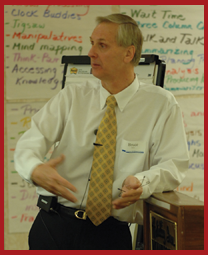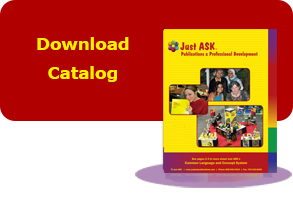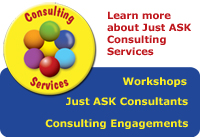
Volume V Issue IV
Share this newsletter on
There Is No Magic Bullet, But…

Bruce facilitating a Leading the Learning® workshop
As 2014 looms and the future of the No Child Left Behind is still unknown, educators continue to search for education’s Holy Grail, the panacea that will be the answer to how can we increase the level of student achievement. This begs the question: Are there tried and true practices that are guaranteed to help schools achieve the illusive 100% passing rate in the next six years? It is clear that there is no one program, publication, trend, or professional development initiative that will solve our achievement conundrum. However, after extensive research, prominent educators including Robert Marzano, Doug Reeves and Larry Lazotte have reached the same conclusion: The single most important factor resulting in higher levels of student achievement is access to the same content, knowledge, and skills regardless of who the teacher might be. In addition, there are other promising practices that are being used in schools that are making a difference in student learning. This month I am sharing some thoughts about those practices.
Have and Act on High Expectations
It sounds so obvious and it is on every list about what makes a difference in student learning. I fear that the construct has lost some of its meaning. It has become one of those platitudes that simply passes through our sub-conscious without any deep thinking about what the words really mean. If we acknowledge that having high expectations for students and ourselves will really make a difference, we must live it and make it a visible part of our words and actions every day. Rick Stiggins writes, “If students conclude there is no hope, it doesn’t matter what the adults decide. Learning stops. True helplessness always trumps pressure to learn.” In schools where unrelenting support for student learning and belief in students’ capabilities are the norm from classroom to classroom, the growth in student learning is evident in student behavior and attitudes toward learning.
Eliminate Deficit Thinking
Far too often, educators look at students in terms of what they cannot do instead of what they are capable of doing. When students are not successful, some of us are too hasty to point out their shortcomings. Very quickly, these students are placed on a list of underachieving students and recommended for special education. This rush to judgment is the wrong approach. In schools where achievement is increasing, teachers do not talk about a student’s lack of ability but instead talk in terms of the student’s level of readiness. As adults and professionals, our self-concepts would take a nose dive if we were judged prematurely as we built our skills and knowledge. We want our evaluators to be patient with us and to give us advice and support as we learn and grow. When students are viewed and treated as capable of higher levels of achievement, they amazingly eliminate their own deficit thinking.
Redefine Discipline
Discipline is often synonymous with punishment. In truth, discipline is derived from the word “disciple” which is defined as a person who learns from another, especially by improving a skill. I am not convinced that students learn a great deal when they are removed from the classroom. I often hear of a decision to suspend a student for three to five days that seems haphazard and random. A recent report from Milwaukee Public Schools revealed that almost 50% of ninth graders in that district are suspended at least once during the school year with many of the students being suspended for multiple days. Schools going to great lengths to “keep kids in school” are seeing the results. Several districts across the country have formally changed their suspension policy and they are seeing the positive impact when they analyze their student achievement data. We must ask ourselves if our discipline policy is really in the best interest of student learning, and if our response to student infractions is appropriate and justified.
Engage Students
When teachers and administrators talk openly about what makes a difference in student learning, one of the first topics to arise is student engagement. Determining when students are truly engaged in learning is tricky. Many young people have perfected their focused looks accompanied with head nods in the direction of the teacher, but their minds are actually elsewhere. It is important for practitioners to create real student engagement through the design and use of learning experiences that require students to engage in meaningful, relevant, and rigorous application of new information and skills in multiple settings. Extensive research concludes that students are better able to engage in learning when the content is personal to them, when the expectations for learning are clearly modeled, when there is emotional and intellectual safety in the classroom, and when students understand their level of accountability.
Be Data Driven
Successful educators who are seeing an improvement in student achievement use multiple measures of learning to inform instruction. They know important information and decisions are derived from frequent checks for understanding and the skillful use of formative assessment data. They use quick and expedient measures of student learning and they respond with timely, appropriate feedback. Their students are able to take corrective action and have another opportunity to show what they have learned. There is strong research evidence that shows when students are given immediate feedback on their work, long-term retention improves. For these teachers, gone are the days when they viewed data unit tests or quarterly assessments as the only measures of student achievement.
Provide On-Going Support
Multiple studies have determined that when teachers provide support for students who do not learn skills and content the first time, the targeted students have a much better shot at reaching a higher level of achievement. Time is always an issue. There is, indeed, a never ending struggle to balance the pressure of adhering to pacing guides as well as the pressure of making sure that all content is addressed. Nevertheless, it makes no sense to press on with new content if segments of the student population have not mastered the current, essential concepts and processes. There are practices that schools use that do not require teachers to find the extra time for remediation. Doug Reeves calls it a “pre-emptive strike,” concluding that up-front thinking and planning may address the concern. Others call it “pre-teaching instead of re-teaching” by proactively filling in gaps in skills and knowledge as a routine part of instructional delivery. Task analysis, pre-assessment, and scaffolding are essential components of this approach. The bottom line is that in schools where a measurable increase in achievement is occurring, the teachers are providing support for struggling students, they are adamant in their beliefs that their efforts are worth the time devoted to these students, and they are unrelenting in their dedication to improving student learning.
Observe Peers
We learn best from what we see. Reading about new practices or hearing a fellow teacher describe a successful teaching approach is not nearly as effective as observing the practice first hand. Hence, when teachers visit each other’s classrooms to see how a colleague works with children, the potential for adding new teaching skills to one’s repertoire increases significantly. But it is not good enough to simply drop in on a peer, stay for a brief time, and then return to one’s classroom. The increase in teaching skills occurs when the two colleagues honestly and skillfully talk about the observation, discuss why the observed teacher employed certain techniques, and ultimately how the observed practices led to student learning. Although the observation itself is powerful, the subsequent conversation brings more meaning and depth, and a level of professionalism, to the observation. A review of the literature reveals that peer observations coupled with follow-up debriefings occur again and again in schools where student achievement is the highest.
Collaborate with Colleagues
Hand in hand with the importance of peer observation is the undeniable importance of teacher collaboration. It is just as important to understand what collaboration is not as well as what collaboration is. Free-wheeling, unstructured meetings with no outcome in mind are not productive. However, when teachers establish an agreed-upon protocol for professional conversations focused on student learning, the results can be not only exciting but lead to observable and measurable improvement in student learning. One structure in which the collaboration can occur is the professional learning community. Dylan William concluded that “…teacher learning communities appear to be the most effective practical method for changing day-to-day classroom practices.” There are a definite set of actions that are important in order for teachers to engage in and then continue to engage in collaborative practices. Each session must be well planned with pre-determined outcomes, discussions must be data-driven, all participants must remain on task, conversations must be focused on student learning, and each member must leave with actions to use in their classrooms. Goal setting, implementing, and problem solving are a normal part of most professions. These practices must be non-negotiable in education if we want learning to improve.
Design and Use Common Assessments
Many promising practices are multifaceted and overlapping. For example, when teachers successfully collaborate, they can also analyze data together. When they focus their conversations on student learning, teachers minimize the likelihood of reducing their conversations to complaining. One exciting and potentially worthwhile venture that can be the by-product of collaboration is the design and use of common assessments and the use of the data to drive instructional decisions across grade levels and content areas. How teachers approach the task of developing common assessments is important. Simply bringing formerly used questions from previous assessments to the planning meeting without determining if the questions truly address the standards they are teaching will result in the development of poor assessments. Some educators tend to make the creation of common assessments a daunting and monumental task. Common assessments need not be lengthy or complicated. They can be administered quarterly, several times a quarter or even weekly. What is critical is that the students are taught the curriculum, and that the teacher has made the criteria for the assessment perfectly clear to the students. The most important step, however, is deciding how to respond to the data created by the assessment results. Teachers can learn new approaches to teaching particular concepts or processes by comparing data results, discussing what worked and did not work well, and then adjusting instructional approaches accordingly. It is not acceptable for educators to go through their entire careers in a vacuum. The insights that can be derived from the development of common assessments and the impact on student learning when the data from the assessments are used correctly cannot be underestimated.
Build Relationships
Anne Wescott Dodd said it best when she wrote, “Teachers must create a classroom environment in which every student comes to believe, ‘I count, I care, I can.’” She further states that unless teachers develop a trusting relationship with their students, teachers will not have the knowledge they need to be able to motivate students and solve classroom problems. Many educators know the importance of building relationships with their students. But there is a huge difference between knowing and knowing how. An accomplished high school teacher states, “If you have a good working relationship with your students, they will work harder for you than if they don’t feel you respect them.” Student learning must be the consistent and constant goal in all schools. Knowledge of content and skill in delivering instruction are the essential skills of all good educators. However, another essential variable in the equation is the relationship that teachers have with their students.
Transcending all of the above ideas is unyielding optimism. I am not talking about an unrealistic view of the world, but a resolute belief that all of us can achieve our goals. The optimism is much more than friendliness and cordiality; it is an uncompromising mindset that the job can be done. The optimism is translated into teacher actions in the classroom where there is excitement, high energy, and a “can do” attitude. I have seen it many times first hand. It is being done!
Permission is granted for reprinting and distribution of this newsletter for non-commercial use only. Please include the following citation on all copies:
Oliver, Bruce. “There Is No Magic Bullet, But….” Just for the ASKing! April 2008. Reproduced with permission of Just ASK Publications & Professional Development (Just ASK). © 2008 Just ASK. All rights reserved. Available at www.justaskpublications.com.



